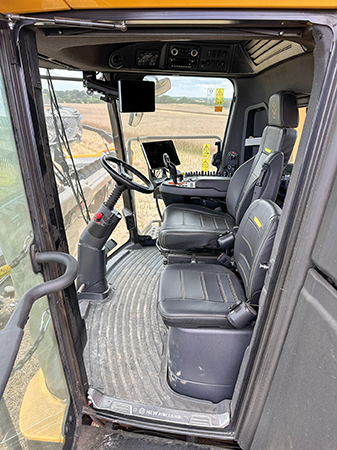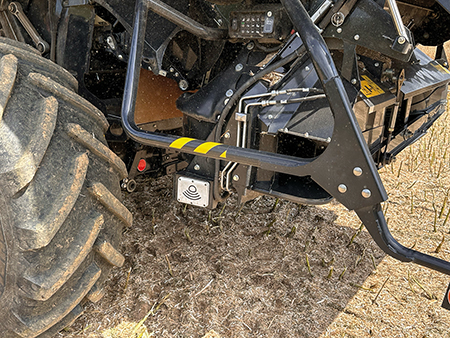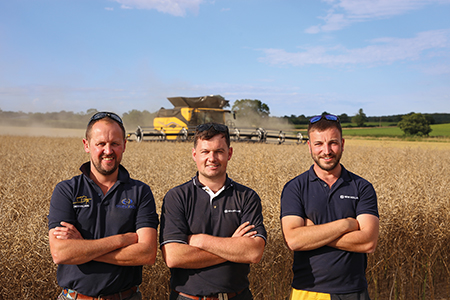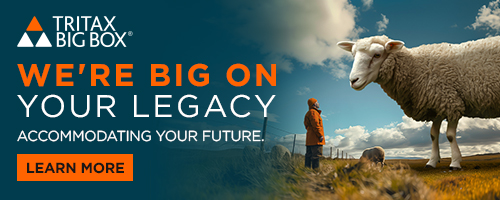New flagship combine impresses with its performance in oilseed rape
22nd August 2024
New Holland’s new combine is attracting plenty of interest from potential customers during low-key demonstration days this harvest. David Williams spent a day with it.
Since it was previewed on New Holland’s Agritechnica stand last autumn, the new CR11 together with its slightly less powerful sibling, the CR10, has intrigued large-scale growers and contractors keen to find out how it performs.
The two new combines are almost identical apart from the engine and grain tank capacities, but with more than 100hp separating the models the CR11 is aimed firmly at those needing the work rate available from a 50ft header, while the CR10 is ideal for working widths of 40–45ft.
Meeting challenge of oilseed rape
Farmers Guide saw the CR11 partnered with a MacDon FlexDraper FD250 50ft header, harvesting oilseed rape on an estate in North Norfolk, as part of a by-invitation demonstration tour by dealer, Ernest Doe.
“It’s accepted that most high output combines perform best in conventional cereal crops, but oilseed rape can be more of a challenge,” explained New Holland demonstrator Stephen Loughnane. “One of the key requirements during the new CR model’s design process was that they would harvest the crop easily without losses or damage. It’s an important factor for potential customers making a buying decision.”
Impressive credentials

The CR11 has 775hp constantly available, a 20,000-litre grain tank, and the demonstration machine with a 50ft MacDon header is believed to be the widest combine currently operating in the UK.
Almost everything is adjustable from the seat; and there is a huge amount of automation including IntelliSense which uses grain quality cameras and a network of sensors to constantly optimise harvesting performance. Closed loop systems check, adjust and re-check constantly, with operator intervention required to verify that required standards are being met. The optional NutriSense NIR sensor records grain quality and nutrient levels in real-time.
Complete redesign
Compared to New Holland’s previous flagships – the CR10.90, and the CR9.90 – the new CR10 and CR11 models are almost completely redesigned. Stephen told Farmers Guide that out of approximately 7,500 component parts, only 500 are shared between the machines. The biggest carry over is the cab, although the new models feature new seats, terminals and additional automation.
Efficient drivelines
One of the biggest changes is to the power transmission. This is simplified and a new layout reduces power losses. The new engine is mounted longitudinally, offset to one side compensating for the lengthy unloading auger, and angled down towards the front of the combine to minimise changes in direction in the power train on the way to the rotor drive. A transmission unit incorporating hydraulic drives, the drive clutch for the header and CVT drive to the rotors is direct mounted to the rear of the engine. The CVT transmits power through a three-speed reduction box to the rotor and allows the threshing system to be disengaged and reversed, making it easy to clear blockages from the cab.
An optional heavy-duty variable speed drive is available for use with large maize headers.
Threshing and separation
At 3.7m long and 600mm diameter, the new rotors are more than one metre longer and 5cm larger diameter than those of the CR10.90, allowing them to achieve thorough separation while treating fragile crops and straw gently. Each rotor has 40 standard rasp bars, eight HX rasp bars and 12 spiked rasp bars. Adjustable vanes allow the operator to select the number of times the crop travels around the rotors from three to nine times, to suit the crop type and conditions.
The new, longer rotors mean that no Positive Discharge Belt is required. Previously this was needed to deliver heavy, wet straw to the chopper or out of the back of the combine for swathing.
Ensuring a clean sample
The CR10 and CR11 combines feature a new TwinClean cleaning shoe, incorporating two cleaning systems running simultaneously. There are two upper sieves, two lower sieves, and two clean grain augers. The cleaning area has been increased to 8.76m2. It is wider, and the centre bar between the sieves has been removed, so the full surface area is available for crop processing.

Unlike the previous flagship combine, the new models no longer rely on a self-levelling cleaning system to maintain efficient operation on slopes. Instead, the sieves use a side-shaking action to continuously redistribute the separated crop across the surface. The innovative but simple system keeps losses close to zero even on slopes up to 28%.
The clean grain elevator is rated at up to 200t/hr, and an optional NutriSense NIR sensor was fitted to the elevator of the demonstration machine.
A grain monitoring camera detects damaged grains and admixture. Anything not considered to be grains in good condition is highlighted on the in-cab display, and this data is also used by the combine’s harvesting optimisation system with automatic adjustments based on acceptable levels set by the operator.
Residue management
The straw chopper has two operating speeds – adjustable from the cab. Retractable knives allow the user to reduce the chopping effort and power demand when conditions are favourable.
Residues are spread across up to 60ft, and IntelliSpread radar spread pattern monitoring constantly checks the performance and adjusts the bias to compensate for variations caused by uneven terrain and windy conditions.
High productivity

The CR10 and CR11 are both capable of operating with a wide range of headers from 10.6–15.0m, in fixed, flexible knife and draper types as well as corn/maize headers from 12–16 rows. The elevator comes standard with front face adjustment and lateral tilt controlled from the cab. The crop is fed to the proven Dynamic Feed Roll system which accelerates the crop and divides it into two even streams for feeding into the two longitudinal threshing and separating rotors. The rotors are protected from foreign object damage by stone traps which are emptied from the cab.
The CR11 grain tank holds 20,000 litres and unloads at 210-litres/sec, while the CR10 holds 16,000 litres and unloads at 159-litres/sec. The unloading system automatically shuts off the cross-auger within the grain tank ahead of the main unloading auger so that it empties before folding. The CR11 allows the user to shut off one cross-auger to reduce the unloading rate by 50%, making it easier to top off trailers. A pivoting spout is standard.
Existing cab with new technology
The cab is like current CR models, apart from the latest IntelliView 12 terminal. There are two of the terminals – one on the armrest and one higher up on the front windscreen pillar. On the demonstration machine, the upper screen displayed information from the NIR sensor, and the lower terminal was used to monitor combine performance and to display the IntelliSense settings.
Crop volumes and yields are calculated and monitored by a Mass Flow system which, once calibrated at the start of the harvest, will maintain accuracy for all crops within 0.5%.
Easy to live with
With the new drive arrangement, the combine remains the same overall width for transport as before, even with wider track belts.
Manoeuvrability is even better than before, assisted by the rear axle moving to the left or right during turns. The tight turning circle was demonstrated on headlands just one 50ft bout wide where the combine turned back on itself for consecutive passes.
Daily maintenance and checks are minimal. The cooling pack is located between the engine and the grain tank where it has access to cool, cleaner air. The fuel tank holds 1,500 litres – more than enough for a full day of work.
A day with the CR11
Farmers Guide spent a day in late July with the CR11, cutting oilseed rape on a North Norfolk estate. The MacDon header ensured an even feed to the intake elevator, and even where there were green areas of crop these fed in smoothly to the separation and cleaning system.
The engine’s maximum 775hp is always available and a display in the corner of the Intellivew screen shows the percentage of available power being utilised. Anything over 100% means that the phenomenal torque reserve is being used to maintain the revs, and it isn’t until the graph displays more than 130% power that the engine speed is pulled back by the extreme loads. The cab is quiet, and the visibility is excellent. During unloading, the auger pivots forwards of its central position to align with the cab window and steps. This allows the driver a very good view of the load entering the trailer, a particular advantage when topping off as even a two-second spillage represents almost half a tonne of crop on the floor.
Positive customer reaction

“Feedback from potential customers has been extremely positive,” explained Ernest Doe, New Holland harvester brand manager, Matt Boardley. “Everyone is excited to see the new technology in action and to experience the next generation of harvesting machinery.”
Matt said that CR9.90 and CR10.90 models remain extremely popular. “The CR10.90 is the current world record holder and customers love its simple design and reliability.
“There is interest in the latest CR10 and CR11 machines from large scale farmers currently using the CR10.90, and both models have also attracted the attention of those with competitor brands. The addition of new flagship models to the line-up will also increase interest in smaller machines, so we expect a busy year. High-capacity combines represent a considerable investment, but across our trading area customers know that they can depend on the back-up of the Ernest Doe team to maximise uptime, especially with superb parts availability provided by New Holland in the UK.”
Visit the Ernest Doe website for more information.
Read more machinery news




